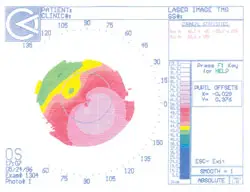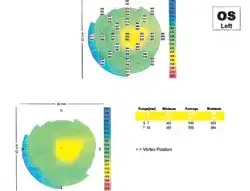Patient K.A. was the most dramatic change in improvement of Keratoconus and nearsightedness reduction. She used special aspheric rigid gas-permeable (RGPs) lenses fit to the healthy superior cornea, ignoring the disease (central and inferior cornea). Contact Lens Spectrum published my article on how Keratoconus can reform and rehabilitate. This a holistic approach with a non-traditional fitting that focuses on the healthy part of the cornea and ignores the disease. This fitting is called "superior intermediate aligned fitting," which preserves and enhances what's living and ignores the rest.
Things that I Personally Observed Improve Keratoconus:
1. Flat fit, aspheric rigid gas permeable lenses: I was originally fit with this traditional method. I had no problems with the mild cone, but I had great pain in the advanced cone and could not tolerate the lens beyond three hours. I currently wear a superior intermediate alignment (flat fit), which means that the contact is fit according to the flatter healthy portion of the cornea.



I am a case in point stressing the need to work the accommodative system. While in optometry school, I played a lot of sports, but then cut back due to the high reading demand. After this, I noticed I couldn't see the board as well in class. As a result, I'm a big proponent for KC patients to use low-powered reading glasses. KGA wears +0.75 D reading glasses over their GP lenses. They are instructed to take a break after 1 to 2 hours of reading or computer work to look far away, rock accommodatively far to near, scan, observe the periphery and do simple yoga exercises to relax the neck and shoulders in the chair.
Things that I Personally Observed Improve Keratoconus:
2. Low-powered reading glasses: My doctor believes that KC patients have weaker accommodative ability that can be assisted through low-powered reading glasses being worn over the RGP lenses when near-point work is being performed. I have been wearing them for several years.
KAG was advised relaxing relieves stress and helps their accommodative system--previously mentioned to be supported by low-powered reading glasses. Meditation and yoga, with relaxing of the neck and shoulders, are excellent relaxation techniques. Myopes, including keratoconics, have too deep an "in" look. Looking "out" helps you see more of the "big picture"--such as with meditation or prayer. Relaxing more frequently helps keratoconus patients build up a reserve or buffer against their stress. I noticed KAG's corneas didn't exhibit as much change, and didn't require as many frequent refits under high-stress circumstances as they did in the past.
Things that I Personally Observed Improve Keratoconus:
3. Relaxation: I observed improvement in before and after pictures after deep, diaphragmatic breathing. Yoga, massage, meditation, and anything else similar are likely beneficial in improving KC.
KAG was advised to start exercising. Exercise not only keeps the body fit, but also reduces stress and rejuvenates the mind, body and soul. Many keratoconus patients are so tense by the end of the day they're not breathing correctly. I suggested they walk outdoors and look at the sky or the surrounding landscape, not the ground. I see many myopic people walk like they're looking for pennies, which does not promote the good, proper breathing needed to release stress. KAG took it a step further, and began exercising their eyes as well.
Things that I Personally Observed Improve Keratoconus:
4. Eye exercises: I saw an article in the newspaper on Meir Schneider who had previously been blind but restored his sight enough through eye exercises so that he was able to obtain a driver’s license. His DVD, “Yoga For Eyes,” came with an eye chart, so I was able to test my before and after vision. At the end of the first session, I was able to read one line higher on the eye chart. My doctor is a staunch advocate of eye exercises.
Over 20 years ago, KAG was placed on the corneal transplant list. Her tenacity to not go for a trasplant, and the various modalities she implemented to improve her overall health also supported in improving her keratoconus. She continues to use her RGPs and hasn't dealt with any issues since we first worked together.
To read about my other cases, go to my Publications page and read other articles on other successful cases I've published on Keratoconus.